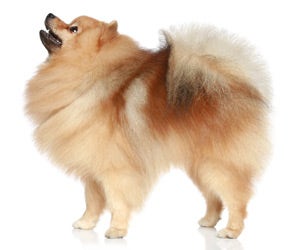Pomeranian
-
Overview
The Pomeranian is the smallest member of the Spitz family. Modern Pomeranians are the diminutive cousins of much larger Northern sled dogs. Queen Victoria's affection for tiny Pomeranians made the toy size universally popular. Today, most Poms only weigh between 3 and 7 pounds and stand 5 to 11 inches tall. Pomeranians are dignified little dogs known for being the companions to many famous owners, including Mozart, Martin Luther, and Michelangelo. Today, they often make appearances peeking out of the purses of their celebrity owners.
-
Personality
-
Coat Care

When you brush your Pomeranian, start at the head to help the coat part naturally, and brush forward so you do not brush against the coat's natural shape. The male's coat, which is much thicker than the female's, requires consistent brushing to maintain its shape and prevent matting. Daily brushing with a slicker brush prevents knots and tangles, which can be painful for your pet.
These dogs will love occasional baths with detangling shampoo. Pomeranians generally shed about once a year, when they will need more frequent brushing and bathing to maintain their shape.
Pomeranians will appreciate some trimming between their routine grooming, especially around their fox-like faces and in between their toes.
Many dog owners are apprehensive about trimming their dog’s nails because they are nervous about cutting into the quick. But with the right conditioning and careful cutting, nail clipping can be a simple, stress-free activity for you and your dog.
Provide your dog with plenty of positive reinforcement and even treats to help associate nail clipping with a positive experience. As you start to clip, gently press on your dog’s paws to help him become accustomed to the feeling of having his nails clipped. Then, work gradually, shaving down just a thin portion of the nail at first to make sure you don’t reach the quick. Clip one nail, reward your dog with a treat, and stop to give him some positive reinforcement before moving on. Gradually increase the number of nails you clip in one sitting to help your dog get used to the process. Never trim extremely long nails down to a short nail in one sitting, because this is an excellent way to accidently quick the dog’s nail. Instead, work gradually, shaving small portions of your dog’s nails off each time.
You can tell if you’re getting close to the quick by the texture of your dog’s nail. The nail is hard closer to the surface and becomes softer as you get closer to the quick. If your dog’s nail starts to feel softer, that’s a good indication that you’re getting close to the quick.
Not all breeds and coat styles require routine trimming in and around the eyes and ears but all should undergo regular inspection and cleaning around these sensitive areas. Doing so will help prevent the development of infections that could seriously damage these amazing organs.
It is always important to routinely clean your dog's eyes and ears, and examine for potential infections. Small dogs, like Pomeranians, and dogs with extremely profuse coats, like Newfoundlands, American Eskimo Dogs and Keeshonds, have ears that need to be checked weekly for infection and cleaned with a cotton ball. Gently wipe a cotton ball moistened with mineral oil, olive oil or witch hazel in your dog's ear, being careful to avoid the ear canal. Never use a Q-Tip, which could cause damage to the inner ear if your dog suddenly shakes or jerks his head. Bushy hair growth within the ear can be thinned with tweezers or blunt scissors. Use a small trimmer to trim excess hair around the eyes, ears and face. Small dogs like Pomeranians and Pekingese, and dogs with white coats like American Eskimo Dogs and Samoyeds, are prone to developing tear stains around their eyes, so clean around their eyes with a cotton ball or soft cloth and use a small trimmer to trim excess hair around their eyes.
Pomeranian's tiny teeth prone to dental problems. Brush at least once a week.

 India (English)
India (English)
 Middle East and Africa (English)
Middle East and Africa (English)
 South Africa (English)
South Africa (English)
 Australia (English)
Australia (English)
 Japan (日本語)
Japan (日本語)
 South East Asia (English)
South East Asia (English)
 Singapore (English)
Singapore (English)
 Europe (English)
Europe (English)
 United Kingdom (English)
United Kingdom (English)
 Argentina (Español)
Argentina (Español)
 Brazil (Portuguese)
Brazil (Portuguese)
 Colombia (Español)
Colombia (Español)
 Latin America (Español)
Latin America (Español)
 México (Español)
México (Español)
 Chile (Español)
Chile (Español)
 Peru (Español)
Peru (Español)
 Canada (English)
Canada (English)

